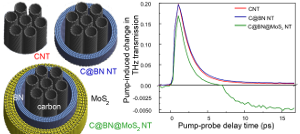News and events
Mobile charges and excitons in 1D radial van der Waals heterostructures
 2D sheets of atomically-thin materials have been intensively studied over the last few years, and have been found to bind together via van der Waals forces to create composites with unique optical and electronic properties. Here we report a study of the atomic structure and optoelectronic properties of some of the first examples of radial van der Waals heterostructures, where cylindrical sheets of different semiconductors (nanotubes) encase other materials. As described in our paper in Nano Letters, we found that BN overgrowth around carbon nanotube bundles created a good template for the creation of high-quality MoS2 nanotubes. This outer semiconducting wall had good electrical properties and strong optical absorption, while the inner carbon nanotubes retained their excellent conductivity. This new class of composite may be suitable for unique functional optoelectronic devices on the nanoscale, such as 1D radial p-n junctions or transistors, for instance where the inner carbon nanotubes electrically control the outer semiconductor's conductivity.
2D sheets of atomically-thin materials have been intensively studied over the last few years, and have been found to bind together via van der Waals forces to create composites with unique optical and electronic properties. Here we report a study of the atomic structure and optoelectronic properties of some of the first examples of radial van der Waals heterostructures, where cylindrical sheets of different semiconductors (nanotubes) encase other materials. As described in our paper in Nano Letters, we found that BN overgrowth around carbon nanotube bundles created a good template for the creation of high-quality MoS2 nanotubes. This outer semiconducting wall had good electrical properties and strong optical absorption, while the inner carbon nanotubes retained their excellent conductivity. This new class of composite may be suitable for unique functional optoelectronic devices on the nanoscale, such as 1D radial p-n junctions or transistors, for instance where the inner carbon nanotubes electrically control the outer semiconductor's conductivity.
Congratulations to Maria and the rest of the collaboration team (which included researchers at WCUS, Warwick Microscopy, the University of Tokyo and Aalto University).
